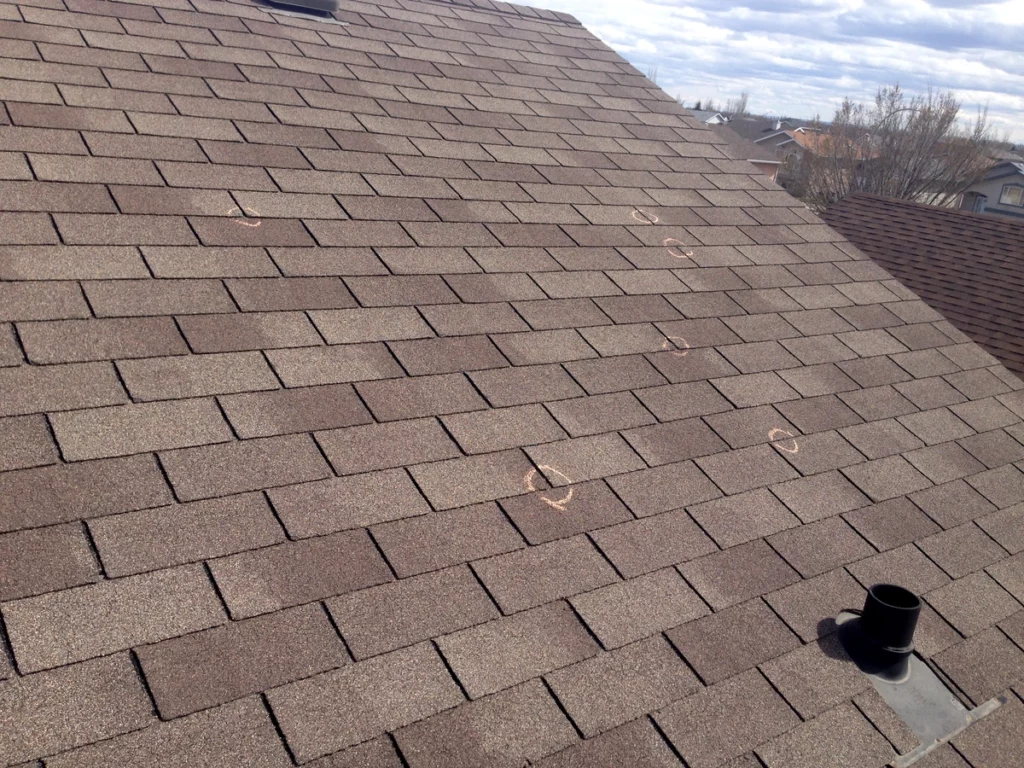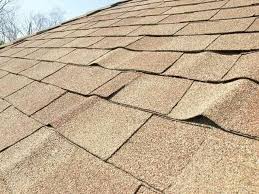When your area gets hit by a hailstorm, everything in its path is fair game for hail damage. That includes your car, patio furniture, landscaping, outdoor decorations, storage elements, exterior siding and windows, and especially your roof.
Of course, it can be difficult to tell when there’s hail damage on your roof if you don’t know the signs. This is largely due to the fact that the damage caused by hailstorms varies greatly. Plus, assessing the damage, in part, requires a close-up inspection of the top of your roof.
Luckily, there are a few ways to know if you have hail damage for sure — and you want to be sure when it comes time to file your insurance claim. In this article, we’ll talk about everything you need to know about spotting the damage post-hailstorm. We’ll also include hail damage roof photos so you know exactly what to look for.
Read on to learn more.

Hailstorms 101
The first thing you need to know about hailstorm damage to your roof is how it occurs — meaning that you need to understand what a hailstorm entails.
Hail is a specific form of precipitation that consists of solid ice. This solid ice is formed by a thunderstorm updraft, which is caused by warm air rising to the level where condensation begins, and precipitation starts developing. Updrafts occur alongside downdrafts, which are the exact opposite, causing the precipitation to cool to varying degrees.
If the precipitation is cooled enough, it can form hailstones. Hailstones can range from mild to incredibly dangerous, depending on the following factors:
The Size of the Hailstones
Each hailstorm will form different-sized hailstones. Therefore, the severity of the damage they can cause to your home’s roof will vary. The range can vary from the size of a pea that’s roughly ¼ of an inch in diameter all the way to the size of a softball.
However, it should be noted that while smaller hailstones have less density, they’re not necessarily safer. Smaller hailstones can have a more rapid impact due to being lighter, which means wherever the wind blows them, they can dent or crack whatever stands in their way.
Hailstones that range up to four inches in diameter will undoubtedly cause severe damage to your home’s exterior. This is because they come from clouds with a much higher density and pick up speed as they fall. This is what makes them so dangerous.
The Shape of the Hailstones

It’s also important to understand that hailstones are not perfectly round objects, even though they seem that way. They can vary in shape and are usually crystalized, which is how they form jagged edges throughout their surface.
The jagged edges they form can easily scratch or pierce everything from your asphalt shingles to your siding, windows, and more.
The Wind Speed and Direction
The last factor that plays into hailstorm damage is wind speed and direction. The wind speed and direction will determine how fast the hailstones travel and in which path. Combined with the size and shape of the hailstones, this can result in extensive damage.
Generally speaking, every two- to four-inch hailstone has a projected speed of impact ranging between 44 and 72 miles per hour. Therefore, the higher the winds and larger the hailstones, the more damage you can expect to have on your roofing system and the rest of your property.
How Roof Hail Damage Is Categorized
Another essential thing to understand about hailstorms is that when it comes to hail damage roof claims, insurance companies categorize the damage in two ways:
- Functional damage
- Cosmetic damage
Hail damage is considered functional when it affects the performance of your roof and its structure. For example, if the asphalt shingles or flashing on your roof are visibility lifted or broken, then you have functional damage on your hands.
Cosmetic damage only impacts the surface of the roof and the home’s exterior. While it’s visible, such as dents or impact marks, it doesn’t keep your roof from functioning correctly.
When there’s only cosmetic damage on your roof, your insurance company will most likely deny your claim for a roof replacement or repairs. However, that doesn’t mean you should ignore it. Cosmetic damage can easily contribute to a speedier deterioration over time as well as cause it to weaken and become severely damaged during the next bad weather event.
What Hailstorm Damage to a Roof Looks Like: 3 Signs

Hail damage to a roof has a pretty specific look. If your roof has hail damage, you’ll likely see:
- Broken or fractured shingles ✅
- Shingles with visible cracks running along them ✅
- Dents & other impact marks on your shingles, chimney, and other areas of your roof ✅
1) Broken or Fractured Shingles
In many cases, hailstorms can cause your shingles to fracture or break. In severe cases, you can expect to see completely broken shingles with pieces in the gutter or on the ground.
The type of hailstorms that cause this usually involve softball-sized hailstones and high winds.
2) Shingles With Cracks
Hailstones can also cause your shingles to crack. These cracks may simply run along the surface or deeper into the body of the shingle. However, cracks can change both the appearance and performance of your shingles.
Eventually, cracked shingles will break off and expose the waterproof membrane and roof deck beneath them.
3) Dents and Impact Marks

Dents and impact marks are often the number of indicators of hailstone damage to a roof. Dents and marks occur when smaller hailstones hit the surface of your roof rapidly, which means you’ll see them all over your roof and not in just one isolated area.
You’ll also see the impact marks and dents near the top of the air conditioning vent, chimney, and virtually everywhere else on your property.
What to Do When You Have Hail Damage on Your Roof
All of the damage that hail can cause will eventually lead to water leakage and structural damage within your home. The dents created by smaller hailstones can contribute to the loss of protective granules on your shingles as well as further deterioration over time.
If you’re positive that your roof has suffered hail damage, the next step you’ll need to take is to get in touch with your local roofing contractor for an inspection right away. Only an experienced and skilled roofer can properly assess the damage and provide you guidance regarding a roof repair or replacement — and they may also be able to support you during the insurance claim process.
Hail Damage Roof Repair

In most instances, the damage that a hailstorm causes to your roof can be repaired. However, it all depends on a variety of factors ranging from the extent of the damage to the age of your roof, which means you could end up needing a complete roof replacement.
The only way to know for sure is to get in touch with your local and trusted roofing contractor to assess the damage. A good roofer will provide you with a free inspection and an accurate, no-obligation estimate that you can use in your insurance claim.
Tidds Roofing is Huntersville’s top-rated roofing company offering roof hail damage services as well as emergency patches. If you think your roof has hail damage, give us a call right away to book your free inspection!



